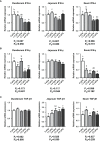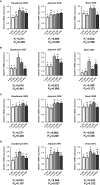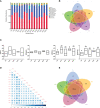Effects of Small Peptide Supplementation on Growth Performance, Intestinal Barrier of Laying Hens During the Brooding and Growing Periods
- PMID: 35874672
- PMCID: PMC9301363
- DOI: 10.3389/fimmu.2022.925256
Effects of Small Peptide Supplementation on Growth Performance, Intestinal Barrier of Laying Hens During the Brooding and Growing Periods
Abstract
The growing period is a critical period for growth and development in laying hens. During this period, chicks grow rapidly, but are accompanied by unstable digestive function, incomplete organ development, and high mortality. Small peptide, a feed additive, which has been proved to promote intestinal development and immunity in poultry. In order to elucidate the effects of small peptides on growth performance, immunity, antioxidant capacity, and intestinal health of growing laying hens, a total of 900 Tianfu green shell laying hens (1-day-old) were randomly divided into 5 treatments with 6 replicates of 30 birds each in this 18-week trial. Dietary treatments included a corn-soybean meal-based diet supplemented with 0 g/kg, 1.5 g/kg, 3.0 g/kg, 4.5 g/kg and 6.0 g/kg small peptide, respectively. The results showed that the supplementation of small peptides significantly increased growth rate (P<0.05) in laying hens, as well as elevated the serum immunoglobulins (P<0.05) and antioxidant indices (P<0.05), however, it decreased inflammation parameters (P<0.05). The supplementation of small peptides enhanced the intestinal function by promoting gut development (P<0.05) and improving gut integrity (P<0.05), barrier function (P<0.05) and the diversity of gut microbiota (P<0.05) in the growing hens. The best performance was recorded among the hens fed 4.5 g/kg level of small peptide. Taken together, these results showed that small peptide supplementation could improve the economic value of growing hens by promoting growth rate, disease resistance, and the optimal amount of addition for Tianfu green shell laying hens was 4.5 g/kg.
Keywords: anti-oxidation; growth performance; immune; intestinal health; laying hen; small peptide.
Copyright © 2022 Zhao, Zhang, He, Wei, Han, Xia, Tan, Yu, Kang, Ma, Zhu, Yin and Cui.
Conflict of interest statement
The authors declare that the research was conducted in the absence of any commercial or financial relationships that could be construed as a potential conflict of interest.
Figures








Similar articles
-
Supplementation of curcumin promotes the intestinal structure, immune barrier function and cecal microbiota composition of laying hens in early laying period.Poult Sci. 2024 Dec;103(12):104355. doi: 10.1016/j.psj.2024.104355. Epub 2024 Sep 24. Poult Sci. 2024. PMID: 39423789 Free PMC article.
-
Effect of dietary supplementation of mannan-oligosaccharides on performance, blood metabolites, ileal nutrient digestibility, and gut microflora in Escherichia coli-challenged laying hens.Poult Sci. 2015 Sep;94(9):2165-72. doi: 10.3382/ps/pev180. Epub 2015 Jul 17. Poult Sci. 2015. PMID: 26188028
-
Effects of sunflower meal supplementation in the diet on productive performance, egg quality and gastrointestinal tract traits of laying hens.Br Poult Sci. 2021 Feb;62(1):101-109. doi: 10.1080/00071668.2020.1814202. Epub 2020 Sep 18. Br Poult Sci. 2021. PMID: 32835498
-
Effects of Modified Palygorskite Supplementation on Egg Quality and Mineral Element Content, and Intestinal Integrity and Barrier Function of Laying Hens.Biol Trace Elem Res. 2018 Dec;186(2):529-537. doi: 10.1007/s12011-018-1335-9. Epub 2018 Apr 16. Biol Trace Elem Res. 2018. PMID: 29658063
-
Effects of dietary vitamins supplementation level on the production performance and intestinal microbiota of aged laying hens.Poult Sci. 2020 Jul;99(7):3594-3605. doi: 10.1016/j.psj.2020.04.007. Epub 2020 Apr 26. Poult Sci. 2020. PMID: 32616256 Free PMC article.
Cited by
-
Probiotic mediated intestinal microbiota and improved performance, egg quality and ovarian immune function of laying hens at different laying stage.Front Microbiol. 2023 Jan 24;14:1041072. doi: 10.3389/fmicb.2023.1041072. eCollection 2023. Front Microbiol. 2023. PMID: 36760506 Free PMC article.
-
Effects of energy density of diets and dietary Pediococcus acidilactici supplementation on productive performance, egg quality, and intestinal function in laying hens.Poult Sci. 2025 Jun;104(6):105118. doi: 10.1016/j.psj.2025.105118. Epub 2025 Apr 1. Poult Sci. 2025. PMID: 40187015 Free PMC article.
-
Iturin A Potentiates Differentiation of Intestinal Epithelial Defense Cells by Modulating Keap1/Nrf2 Signaling to Mitigate Oxidative Damage Induced by Heat-Stable Enterotoxin B.Antioxidants (Basel). 2025 Apr 16;14(4):478. doi: 10.3390/antiox14040478. Antioxidants (Basel). 2025. PMID: 40298845 Free PMC article.
-
Soybean bioactive peptide supplementation improves gut health and metabolism in broiler chickens.Poult Sci. 2025 Feb;104(2):104727. doi: 10.1016/j.psj.2024.104727. Epub 2024 Dec 22. Poult Sci. 2025. PMID: 39729732 Free PMC article.
-
Influence of Body Weight at the End of the Brooding Period on the Productive Performance in Hyline Brown Laying Hens from 6 to 72 Weeks of Age.Animals (Basel). 2025 Apr 30;15(9):1292. doi: 10.3390/ani15091292. Animals (Basel). 2025. PMID: 40362111 Free PMC article.
References
-
- Abd El-Hack ME, Mahrose K, Askar AA, Alagawany M, Arif M, Saeed M, et al. . Single and Combined Impacts of Vitamin a and Selenium in Diet on Productive Performance, Egg Quality, and Some Blood Parameters of Laying Hens During Hot Season. Biol Trace Elem Res (2017) 177(1):169–79. doi: 10.1007/s12011-016-0862-5 - DOI - PubMed
Publication types
MeSH terms
Substances
LinkOut - more resources
Full Text Sources

